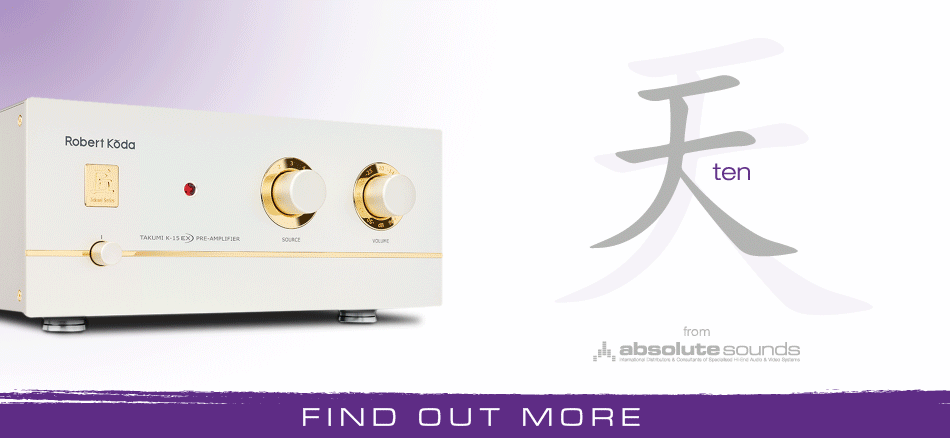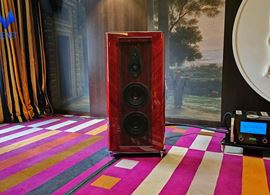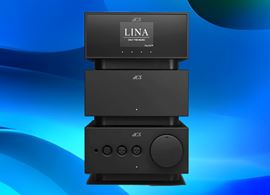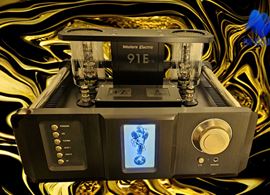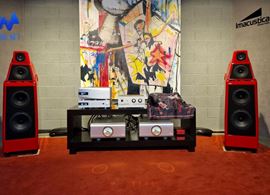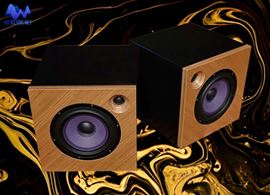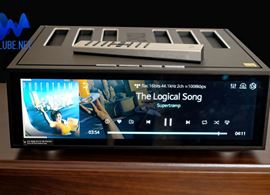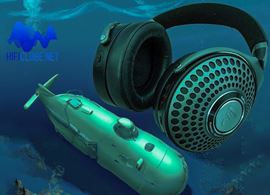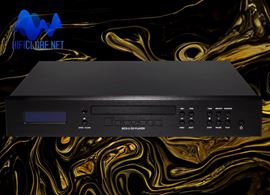The Riviera Labs AIC-10 BAL hybrid stereo headphone/speaker power amplifier, with its all-analogue technology, restored my faith in humanity during an age dominated by digital devices.
"There is no such thing as an absolute in musical sound reproduction; or there is no such thing as an absolute piece of equipment, a system or a component that performs optimally in any situation in all musical genres.
There is and always will be a need for tonal adjustment and acoustic adaptation, which are first and foremost arts rather than techniques. That's the crux of the matter.
It's a personal and non-transferable art that can't be learned in schools, books, or even commercial magazines. Because what may be good for me may not be good for a "normal" person." Holbein Menezes, April 2007
Note: Holbein Menezes, a renowned audiophile from Brazil, has sadly passed away this February at the age of 99.
Music for human use
According to this premise, it is easy to understand why Riviera Labs produces amplifiers that are adjusted to suit the human ear, without giving much importance to THD (Total Harmonic Distortion).
This is quite a risky move, considering that specialised critics use the Audio Precision 555, which can measure distortion up to 0.005% or even 0.0005%, while "normal" people can tolerate distortion 100 times higher, up to 0.5% (and even enjoy it!), as seen in tube amplifiers.
Note: Read this article 'BB Tubes, Beauty and the Beast' that I published on Hificlube. It’s about a software that adds 'tube' distortion to the signal to allegedly improve sound quality, as confirmed by some of the most famous engineers responsible for mastering discs, who vouch for the results they get.
Maître Jean Hiraga
Jean Hiraga wrote a controversial article titled "The Musicality of Amplifiers - A Study of Harmonic Distortion and Spectral Analysis." The article presents a different understanding of the importance of the quality of distortion over the quantity.
Hiraga wrote this article after reading a study conducted by a Japanese university that analysed the timbre of hundreds of violins. The study concluded that the difference between the timbre of a Stradivarius and a modern violin is due to the harmonic pattern of the notes produced, and not the fundamentals.
According to Hiraga, musicality transcends technical specifications. What matters is not the amount but the pattern of distortion, which the ears use to recognise timbre.
Note: Interested readers may read here the famous debate between Jean Hiraga, Jan Didden and Dennis Colin: Musicality and Distortion: A Conversation | audioXpress.
Golden Ears vs. Objectivists
The conflict between "Golden Ears" and Objectivists marked the beginning of an endless war. "Golden Ears" believe that the spectral composition of sound is more important than distortion, while Objectivists argue that all types of distortion are unacceptable in a well-designed amplifier, even though distortion is measured with pure tones and not music.
Music is made up primarily of harmonics that give each instrument or voice its own distinct timbre and character. The fundamentals establish the basic pitch of a note. These harmonics create the intricate and rich sound that we all perceive when listening to music.
This discussion ultimately reflects the current tension between subjectivity and objectivity in assessing sound quality. Each side has its merits, and the choice between "Golden Ears" and Objectivists often depends on personal preferences and priorities.
I have come across various technical arguments both in favour and against, as well as good and bad acoustic examples from both sides. Reason suggests that the less distortion, the better, while emotion disagrees and claims that it's not always the case. However, the former provides scientific evidence, while the latter is based on individual conjectures.
Despite this, I would like to share my opinion, which is solely based on my auditions, for what it's worth. Ultimately, you should experience it for yourself to draw your own conclusions with an open mind. I urge you to listen before you judge, as there are more things between heaven and earth than science can explain.

Luca Chiomenti, Riviera Labs booth at Highend 2023, Munich
Luca Chiomenti, the Designer
Luca Chiomenti, the designer of Riviera Labs, made a conscious decision to use dual triodes in the input stage, pure Class A operation in all stages, and zero global feedback (only local), even though his amplifiers would not measure well by conventional technical standards.
It would have been easy for him to use operational amplifiers and negative feedback to achieve a cleaner measurement sheet that would please the Objectivists, but he prioritised sound quality over conventional technical standards. I tend to agree with him after listening to the AIC-10 BAL.
Luca is not your typical DIY enthusiast who tinkers with amplifiers on his kitchen table. He is a graduate of Politecnico di Milano and has been developing audio projects for various companies for years. And, of course, he understands what it takes to fool test gear and achieve excellent results, but chose otherwise. Why?
Like Jean Hiraga, whom I have also had the pleasure to meet in person, he has chosen to focus on building amplifiers that provide exceptional music experiences and cater to the complex auditory physiology of human beings, rather than just delivering perfect measurements on the bench.
Distortion pattern
Luca believes that the human ear produces up to 10% second harmonic distortion in everything we hear. However, our brain has a remarkable ability to remove this distortion, and we hear a pure tone instead. If an amplifier's distortion pattern matches that of the human ear, the brain suppresses it in the same way.
Zero Global Feedback
Global feedback is often used to stabilise the amplifier and optimise its score on SINAD tests. However, it also eliminates non-dissonant distortion that sounds pleasant and natural to the human ear. At the same time, it introduces phase shifts and musically unrelated high-order harmonics, which are dissonant and unpleasant to the auditory system. This is a bad trade-off for audiophiles.
Harry Nyquist is quoted as having said: “Negative feedback applied to an electronic circuit is like a dog chasing its tail.”
Note: (1) 'Evaluating SINAD - Why It's not Important.

Silvio Delfino (photo courtesy of Riviera Labs).
Silvio Delfino
Riviera Audio Laboratories was founded in Italy in 2017 and was first introduced to me at Highend in Munich in 2018 by Silvio Delfino, who founded the company together with Marco Muzio, the industrial designer responsible for the beautiful metal safe in which Luca Chiomenti's electronic jewellery is stored.

Riviera Audio Laboratories presentation at HIFI'23 Lisbon.
I've known Silvio Delfino for so many years that I can't remember exactly when and where I first met him and learned about the many audio products he has represented and distributed. But Riviera Labs seems to be his life project.
And how I understand him after listening to the Riviera Labs AIC-10 BAL headphone amplifier. I only wish I could afford it. And not just as a headphone amplifier, but also as a loudspeaker amplifier: it's 10 W of pure listening pleasure!
Note: Read the Technical Overview by Luca Chiomenti
More than just the looks
It's easy to see why the AIC-10 BAL headphone amplifier has such a high price tag of €20,000 (ouch!) with its top-quality build, sturdy design, and luxurious finishes. However, its true value lies in the exceptional sound quality it produces.
The AIC-10 BAL is an outstanding product crafted with high-quality metalwork, including a thick engraved panel, heat sinks that match the rounded edges, and internal components that are hand-soldered onto double-sided, 2 mm thick circuit boards.
The AIC-10 BAL was sent to Hificlube by Ajasom, the official distributor in Portugal. It comes in a champagne colour with three golden buttons to select the input line (Line 1/Bal, Line 2, Line 3), output (High Gain, Low Gain, Speakers), and volume. There is also an anthracite-colored version with silver buttons available, but the champagne version is my preferred choice.

The AIC-10 BAL remote only controls volume.
Pure Class A hybrid amplifier
The AIC-10 BAL is a hybrid amplifier that uses a dual triode (12AU7/ECC82) in the preamp stage and Mosfets in the output stage. This pure Class A amplifier comes with a medium-gain Slovak JJ valve, which is also used in guitar amps. However, you can customise the sound by experimenting with different valves from Mullard or Radiotechnique.
Based on my personal experience with Mullard (warmer) and Radiotechnique (more neutral) valves in a McIntosh preamplifier, I suggest you try the latter if you can still find one in specialised shops. But I also enjoyed the JJ Gold, which offers a smooth sound with well-defined tones.

AIC-10 BAL internal layout. Swapping the double triode is a breeze.
Tube swapping
The Brimar CV4003, which also comes included in the package, sounds even warmer, and sounds full-bodied with a golden emphasis on the middle registers, especially the voices that seem to jump out of the soundstage. I finally decided in favour of the Brimar as being closer to my kind of tube sound, although the JJ delivered a tighter bass.
On the front, below the function selection buttons, you'll find two headphone outputs: a 6.35mm jack and a 4-pin XLR. The internal circuitry is the same, so you won't hear any difference except for the quality of the connection.

Riviera AIC-10 BAL back connections
On the back, you’ll find 3-line inputs (one XLR) and the terminals for connecting speakers. The declared power output for speakers is just 10W/8 ohms, which is enough to power a pair of medium-sensitivity speakers (88dB) in a small room if you don't push it too hard. Surprise: the Riviera AIC-10 BAL is also a remarkable low-power speaker amplifier.
Uncanny authenticity
I started with a pair of Sonus faber Concertino speakers, then moved on to the new Franco Serblin Accordo Goldberg speakers, both of which are also Italian-made. I'm amazed by the quality of sound I'm hearing every day, even though I was only planning to use them with headphones.
I spent several days listening to the AIC-10 BAL with speakers when I should have been using headphones instead for this review. But that doesn't mean I didn't like the AIC-10 BAL in its primary function. It so happens that the Riviera AIC-10 BAL is an exceptional analogue amplifier primarily designed for high-quality sound through headphones that also excels as a speaker stereo amplifier.

The Riviera AIC-10 BAL driving a pair of HEDDphones TWO.
I got the best sound ever out of my Hifiman HE1000s, and I didn't even need to equalise them! I also tried the AIC-10 with a pair of the brand-new hybrid-ribbon HEDDphones TWO and a pair of Raal Requisite SRb1(see below), both of which produced amazing results. However, it's a shame that the AIC-10 is so expensive, or else I would have kept it instead of unwillingly having to return it.
The Riviera AIC-10 BAL is an exceptional analogue headphone amplifier that also excels as a speaker stereo amplifier.

The Riviera AIC-10 driving a pair of very low impedance (0,5 Ohm) with the indispensable impedance transformers and open baffle compensators.
Un vero capolavoro!
The AIC-10 BAL offers unparalleled control over bass and extension. The mids are incredibly authentic, while the highs are enchanting in their golden glow. The sound stage produced by this device is believable, as is the volumetry of all its components, which are well-defined in both time and space. They are also well differentiated in timbre, and solidary in harmony. The AIC-10 BAL also boasts impressive attack, dynamics, and rhythm, along with remarkable speed. It has everything! Well done, Luca: AIC-10 BAL è un vero capolavoro! (a true masterpiece).
My challenge is now having to bid farewell to the AIC-10 BAL. Just let me savour it for as long as I can, guys.
Note: Ajasom sent me the Riviera Labs AIC-10 BAL so I could use it to power the RAAL Requisite SRb1 full-ribbon headphones, via the impedance transformers that are indispensable (see test here) due to the ultra-low impedance. With both the TI 1B (line output) and the TI 1C (speaker output), the results were also remarkable, particularly with the latter. This is a must-listen match.
Conclusion:
The Riviera Labs AIC-10 BAL is an all-analogue hybrid headphone amplifier that, until today, is the best I have ever heard. However, it is also the most expensive one. The speaker stereo power amplifier is like the delicious icing on the cake. I had the chance to taste it, and now I can only dream of having it too.
Headphone Integrated Amplifier
- Power 10-10W/8 ohm
- Zero Feedback
- Pure “Class A”
- Hybrid design (Triode, BJT, Mosfet)
- 1 Balanced line input (XLR)
- 2 Line Input (RCA)
- Balanced and ¼ inch unbalanced headphone connectors
- Switchable loudspeakers output
- Dimensions: 26×43.5×14.5h cm. Weight: 14.4 Kg.
- 15 to 20,000€, depending on country VAT

